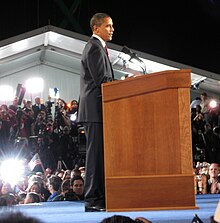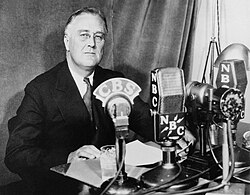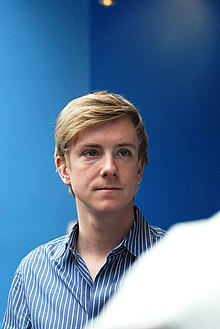Lentis/New Media and the United States Presidential Election of 2008
Introduction
[edit | edit source]This chapter explores the 2008 U.S. presidential election between Barack Obama and John McCain. We examine the rise in social media usage and its impact on supporter tactics and campaign strategies that psychologically influenced voters. Participants include the Obama team, the American voters, household celebrities, viral video creators, Google, Facebook and Twitter. We discuss innovative techniques that leveraged social media and their influence on future elections.


Historical Perspective
[edit | edit source]FDR's Fireside Chats and the 1960 Presidential Debates
[edit | edit source]
Throughout history, U.S. Presidents have used technology to market their message and create a personal relationship with the American public.
When Franklin Delano Roosevelt took office in 1933, about 90% of American households owned a radio. Recognizing the technological trend, FDR leveraged the device through his famously coined "Fireside Chats", a radio broadcast where he addressed the American public directly. Throughout his presidency, FDR delivered 29 speeches with topics ranging from the Great Depression to World War II.[1] His use of the radio gave him a one-to-many relationship with Americans. Using simple language and concrete examples, FDR leveraged technology to market his message and ideals to the public.
Similarly, John F. Kennedy recognized the growing technological trend of television in 1960. About 40% of the population watched the "Great Debates of 1960" between JFK and Richard Nixon.[2] Nixon seemed sickly and awkward, having just been released from the hospital. Kennedy, on the other hand, presented a calm and ready image to Americans. JFK leveraged the television to market his youth and energy, winning the presidency in 1960.
Rise of Internet Usage and Social Media
[edit | edit source]From 2000 to 2009, internet usage increased from 52% to 74% among Americans. In the same period, social media gained traction, growing from 7% to 38% in American membership.[3] Sites like Facebook, Twitter, and YouTube turned the internet into a powerful tool for sharing information among peers in an online community. Facebook and Twitter allowed users to freely share informative content with other users. The growth of video sharing websites like YouTube allowed users to freely post self-published videos to millions of viewers.
The growing number of internet users prompted news outlets to move online. In 2008 we saw the intersection of social media and online political news with 35% of voters using the internet to get information about candidates.[4] From candidate videos to political commentaries, social media users shared election-related content and in turn engaged previously inactive voters. This especially impressed young voters as people age 18 to 29 were twice as likely to use social media.[5] 2008 saw a 4% increase in voter turnout among eligible millennial voters.[6] This spike in participation can largely be attributed to the sharing of political content on social media.
YouTube and New Media
[edit | edit source]
Prevalence of YouTube in 2008
[edit | edit source]Like the radio in 1933 and the television in 1960, YouTube was a growing media outlet that densely penetrated households. In 2008, YouTube was the most viewed online video source with two times more unique viewers than its closest competitor. YouTube was increasingly popular among the younger generation, with 80% of 18 to 34 year-olds watching online videos. The technological trend of online video consumption fundamentally changed media intake. The month before the 2008 election, over 100 million Americans viewed online videos.[7] In previous elections, statements and gaffs were disseminated through newspapers and televised broadcasts. A voter could only be reached if they sought out news and were engaged in the political process. The ability to easily replay and share online videos changed how Americans received information and increased previously inactive voters' exposure to political content. YouTube provided the opportunity to reach millions of Americans and politicians now had this power at their disposal.
Impact of Viral Videos
[edit | edit source]Viral videos played a large role in the 2008 presidential election. An Obama supporter created a viral video titled "Crush on Obama" that received 26 million views. The video highlighted Obama's charisma and showcased the passion of his supporters. Pop singer Will.i.am also published a viral video in support of Obama titled "Yes We Can". The video showed popular American celebrities singing one of Obama's speeches. The chant "Yes We Can" became a slogan for the Obama campaign and originated from this viral video.[8] Saturday Night Live is famous for their satiric sketches that depict politicians during elections. A popular character in 2008 was Tina Fey's Sarah Palin impersonation. In previous elections, SNL sketches were only seen by people who tuned in. Through sharing on social media, the comedy sketches were replayed and viewed millions of times after their original airings.
Selective Exposure Theory
[edit | edit source]Joseph T. Klapper explored the psychological effects of mass media. Klapper poses that appealing to group norms leads to more influential mass communication; responsiveness to mass media increases as the content closer aligns to the consensus of a group.[9] This psychological effect was evident in the 2008 presidential election. As each viral video gained popularity, a stronger sense of group formed among the Obama supporters. Videos like "Crush on Obama" spoke to a consensus feeling of being drawn to Obama's charisma. Much of his appeal came from his personality, and this video spoke to those feelings. The "Yes We Can" video spoke to the group norm of valuing celebrity endorsements. The American public psychologically enjoys sharing views with celebrities, and this sentiment helped "Yes We Can" go viral.
Obama's Campaign Strategy
[edit | edit source]
Internet Presence
[edit | edit source]Barack Obama appointed young, tech-savvy campaign directors to leverage the growing use of social media. Chris Hughes, co-founder of Facebook, and Joe Rospars, founder of Blue State Digital, held high-ranking positions and were both 25 years-old. Obama also hired Kevin Malover, founder of Orbitz, to develop his online platform.[10] The Obama team created a strong social media foothold, accumulating 2.5 million Facebook supporters, 112 thousand Twitter followers and 18 million YouTube channel views.[8] In comparison to McCain, Obama had 6 times as many MySpace friends, 5 times as many Facebook followers and 11 times as many YouTube subscribers.[11]
The Obama team converted their online support into active volunteers, raising $500 million through their website and recruiting 2 million volunteers that organized over 200,000 offline campaign events.[12] The Obama team identified the high volume of voter presence online, and created a platform to connect with supporters. Using their social media expertise, Obama's team understood qualities of internet trends and viral videos. Creating a similar aura around their candidate, the Obama brand was marketed like a popular product, resulting in an influx of online support.
Mobilization and Outreach
[edit | edit source]The Obama team created a hybrid organizational model that used both hierarchical and participatory approaches. A hierarchical approach consists of recruiting formal volunteers and assigning specific task forces. A participatory approach consists of fueling supporters' entrepreneurial spirit through promoting maverick activities. Obama's team used social media to merge these approaches; they amassed a large following online and guided supporters to both spontaneous and organized projects.[12] This innovative tactic embodied the progressive mindset of Obama's team. They integrated the free-thinking nature of social media with the precision of their outreach plans, resulting in a movement that at the surface felt inclusive and inspiring, and behind the scenes was methodical and organized.
The Obama team also used YouTube to address supporters directly. For example, Obama was criticized for his relationship with Reverend Jeremiah Wright during the campaign. Obama posted his speech addressing the issue on YouTube where it was viewed over 2 million times. Social media allowed Obama to share his message with an audience size that far exceeded the viewership of a one-time broadcast. The Obama team used YouTube's large viewership to market their candidate, address criticisms directly and build on their online supporter base.
Results and Lasting Impact
[edit | edit source]
2008 Election Results
[edit | edit source]Barack Obama earned 365 electoral votes, exceeding the 270 vote threshold and winning the presidency.[13] In 2008, 67% of social media users were under the age of 30, a demographic that is largely attributed to Obama's victory.[14] Obama dominated among young voters, winning 66% of voters under the age of 30.[15] Although democrats have won among young voters since 1992, Obama's margin was a 12% increase from 2004.[16] Exit polls also revealed 57% of voters felt Obama was in touch with their needs and a third of his supporters were contacted personally during the campaign.[17] These statistics align with Obama's campaign strategy, providing evidence of his success in using technology to target social media users and foster a personal connection with voters. From accumulating social media followers to sharing viral videos created by supporters, the campaign team flooded young voters with their product, Barack Obama. The snowballing effect of sharing on social media transformed their message into a movement, creating a wave of support that Obama rode to the presidency.
2014 U.K. Labour Party
[edit | edit source]In 2014, the UK Labour Party modeled their campaign strategy off of the 2008 U.S. presidential election. After seeing Obama's success in reaching younger voters through social media, the Labour party realized they could no longer rely on the traditional methods of newspaper and television. They recognized the importance of establishing an online presence and sharing their ideas with younger voters through social media. Other prominent political parties from around the world have adopted similar campaign strategies, using the power of the internet to market their candidate and foster personal relationships with voters.[18]
2012 and 2016 U.S. Presidential Elections
[edit | edit source]Learning from the 2008 presidential race, Mitt Romney used social media in the 2012 election to reach younger voters. The Obama team, however, strengthened their online presence, expanding to new media platforms like Pinterest, Instagram, and Tumblr. Obama spent ten times more money on digital campaigning and retained the presidency in 2012.[19]
We also saw the use of social media in the 2016 presidential race. During the primary season, Donald Trump, Hilary Clinton, and Bernie Sanders posted a total of 713 tweets in a three-week span. A month before the election, Donald Trump and Hillary Clinton posted a combined 629 times on Facebook.[20] To appeal to younger voters, Clinton made an appearance on the online comedy series Between Two Ferns, which had 14 million YouTube views, and Donald Trump hosted Saturday Night Live where his viral sketch "Hotline Bling Parody" received 8 million YouTube views. The increased use of social media in politics illustrates the lasting impact of the 2008 presidential election. As membership on social media continues to increase, the potential audience for politicians grows larger. In 2008, Obama leveraged a technological trend to reach young voters, and major global candidates have since followed his lead.
Conclusion
[edit | edit source]The 2008 U.S. presidential election illustrates the power of recognizing a technological trend and using it to build a movement. New media has historically influenced elections, and Obama leveraged social media to mobilize and inspire large masses of people. Social media usage has become standard practice for politicians, establishing group norms through online communities and direct communication with voters. New technological trends are powerful and constructing strategies around them often leads to success. We focused primarily on YouTube in this chapter and further analysis of Facebook and Twitter's impact would strengthen this case study. A closer look at the McCain campaign strategy would improve this chapter as well.
References
[edit | edit source]- ↑ Ryfe, D. M. (2001). From media audience to media public: a study of letters written in reaction to FDR's fireside chats. Media, culture & society, 23(6), 767-781.
- ↑ Allen, E. T. (2010). The Kennedy-Nixon Presidential Debates, 1960. The Museum.
- ↑ Rainie, L. (2010). Internet, broadband, and cell phone statistics. Pew Internet & American Life Project, 5.
- ↑ Perrin, A. (2015). Social Media Usage: 2005-2015. Retrieved December 11, 2016, from http://www.pewinternet.org/2015/10/08/social-networking-usage-2005-2015/
- ↑ Perrin, A. (2015). Social Media Usage: 2005-2015. Retrieved December 11, 2016, from http://www.pewinternet.org/2015/10/08/social-networking-usage-2005-2015/
- ↑ Fry, R. (2016). Millennials match Baby Boomers as largest generation in U.S. electorate, but will they vote? Retrieved December 11, 2016, from http://www.pewresearch.org/fact-tank/2016/05/16/millennials-match-baby-boomers-as-largest-generation-in-u-s-electorate-but-will-they-vote/
- ↑ ComScore. (2008, December 9). YouTube Attracts 100 Million U.S. Online Video Viewers in October 2008 [Press release. Comscore.com. Retrieved December 11, 2016, from http://www.comscore.com/Insights/Press-Releases/2008/12/YouTube-Reaches-100-Million-US-Viewers?cs_edgescape_cc=US]
- ↑ a b Metzgar, E., Maruggi, A.(2009) Social Media and the 2008 U.S. Presidential Election.
- ↑ Klapper, J. T. (1957). What We Know About the Effects of Mass Communication: The Brink of Hope. Public Opinion Quarterly, 21(4), 453. doi:10.1086/266744
- ↑ Pew Research Center: Journalism & Media staff. (2008). McCain vs. Obama on the Web. Retrieved December 11, 2016, from http://www.journalism.org/2008/09/15/mccain-vs-obama-on-the-web/
- ↑ a b Vaccari, C. (2010). “Technology Is a Commodity”: The Internet in the 2008 United States Presidential Election. Journal of Information Technology & Politics, 7(4), 318-339. doi:10.1080/19331681003656664
- ↑ FEDERAL ELECTIONS 2008 Election Results for the U.S. President, the U.S. Senate and the U.S. House of Representatives [Pamphlet]. (n.d.). Washington, DC.
- ↑ Wormald, B. (2013). Social Media Use by Age Group Over Time. Retrieved December 11, 2016, from http://www.pewinternet.org/data-trend/social-media/social-media-use-by-age-group/
- ↑ [1]RoperCenter. (n.d.). How Groups Voted in 2008 - Roper Center. Retrieved December 11, 2016, from http://ropercenter.cornell.edu/polls/us-elections/how-groups-voted/how-groups-voted-2004/
- ↑ RoperCenter. (n.d.). How Groups Voted in 2004 - Roper Center. Retrieved December 11, 2016, from http://ropercenter.cornell.edu/polls/us-elections/how-groups-voted/how-groups-voted-2004/
- ↑ Rosentiel, T. (2008). Inside Obama’s Sweeping Victory. Retrieved December 11, 2016, from http://www.pewresearch.org/2008/11/05/inside-obamas-sweeping-victory/8/
- ↑ Compton, J. R., & Benedetti, P. (2010). Labour, New Media And The Institutional Restructuring Of Journalism. Journalism Studies, 11(4), 487-499. doi:10.1080/14616701003638350
- ↑ Pew Research Center: Journalism & Media staff. (2012). How the Presidential Candidates Use the Web and Social Media. Retrieved December 11, 2016, from http://www.journalism.org/2012/08/15/how-presidential-candidates-use-web-and-social-media/
- ↑ Donald Trump as President? Thank Facebook. | ezyinsights. (2016). Retrieved December 11, 2016, from https://ezyinsights.com/blog/2016/11/01/donald-trump-as-president-thank-facebook/
